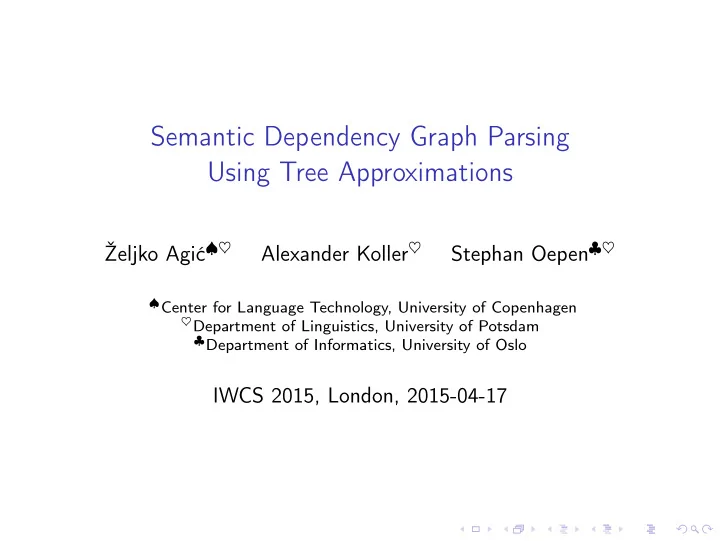

Semantic Dependency Graph Parsing Using Tree Approximations Željko Agić ♠♥ Alexander Koller ♥ Stephan Oepen ♣♥ ♠ Center for Language Technology, University of Copenhagen ♥ Department of Linguistics, University of Potsdam ♣ Department of Informatics, University of Oslo IWCS 2015, London, 2015-04-17
Dependency tree parsing
Dependency tree parsing
Dependency tree parsing ◮ it is also a big success story in NLP ◮ robust and efficient ◮ high accuracy across domains and languages ◮ enables cross-lingual approaches
Dependency tree parsing ◮ it is also a big success story in NLP ◮ robust and efficient ◮ high accuracy across domains and languages ◮ enables cross-lingual approaches ◮ and it is simple
The simplicity Coord Sb Pred Pred He walks and talks . Sb Sb
The simplicity Coord Sb Pred Pred He walks and talks . A0 A0
The simplicity Coord Punc Sb Pred Pred He walks and talks . A0 A0
The simplicity Pred Punc Pred Sb Coord He walks and talks . A0 A0
The simplicity With great speed and accuracy, come great constraints. ◮ tree constraints ◮ single root, single head ◮ spanning, connectedness, acyclicity ◮ sometimes even projectivity ◮ there’s been a lot of work beyond that ◮ plenty of lexical resources ◮ successful semantic role labeling shared tasks ◮ algorithms for DAG parsing ◮ but? ◮ it’s apparently balkanized , i.e., the representations are not as uniform as in depparsing
Recent efforts ◮ Banarescu et al. (2013): We hope that a sembank of simple, whole-sentence semantic structures will spur new work in statistical natural language understanding and generation, like the Penn Treebank encouraged work on statistical parsing. ◮ Oepen et al. (2014): SemEval semantic dependency parsing (SDP) shared task ◮ WSJ PTB text ◮ three DAG annotation layers: DM, PAS, PCEDT ◮ bilexical dependencies between words ◮ disconnected nodes allowed
SDP 2014 shared task
SDP 2014 shared task ◮ uniform, but not the same ◮ PCEDT seems to be somewhat more distinct ◮ key ingredients of non-trees ◮ singletons ◮ reentrancies: indegree > 1
Reentrancies
Reentrancies
Parsing with tree approximations Hey, these DAGs are very tree-like. Let’s convert them to trees and use standard depparsers!
Parsing with tree approximations
Parsing with tree approximations ◮ flip the flippable, baseline-delete the rest ◮ train on trees, parse for trees, flip back in post-processing
Parsing with tree approximations ◮ flip the flippable, baseline-delete the rest ◮ train on trees, parse for trees, flip back in post-processing ◮ works OK...ish ◮ average labeled F 1 in the high 70s ◮ task winner votes between tree approximations
Where do all the lost edges go? ◮ the deleted edges cannot be recovered ◮ upper bound recall ◮ graph-tree-graph conversion with no parsing in-between ◮ measure the lossiness ◮ new agenda ◮ inspect the lost edges ◮ build a better tree approximation on top
Where do all the lost edges go?
Where do all the lost edges go? ◮ there are undirected cycles in the graphs ◮ interesting structural properties? ◮ discriminate specific phenomena they encode?
Undirected cycles ◮ we mostly ignore PAS from now on ◮ DM: 3-word cycles dominate (triangles) ◮ PCEDT: 4-word cycles (squares) ◮ sentences with more than one cycle not very frequent
Undirected cycles ◮ DM, PAS: mostly control and coordination ◮ PCEDT: almost exclusively coordination ◮ supported also by the edge label tuples, and the lemmas
Back to tree approximations ◮ edge operations up to now ◮ flipping – comes with implicit overloading ◮ deletion – edges are permanently lost
Back to tree approximations ◮ edge operations up to now ◮ flipping – comes with implicit overloading ◮ deletion – edges are permanently lost ◮ new proposal ◮ detect an undirected cycle ◮ select and disconnect an appropriate edge ◮ radical: overload an appropriate label for reconstruction, or ◮ conservative: trim only a subset of edges using lemma-POS cues ◮ in post-processing, reconnect the edge ◮ by reading the reconstruction off of the overloaded label, or ◮ by detecting the lemma-POS trigger ◮ we call these operations trimming and untrimming
Trimming and untrimming
Upper bounds
Parsing ◮ preprocessing: trimming + DFS + baseline = training trees ◮ training and parsing ◮ mate-tools graph-based depparser ◮ CRF++ for top node detection ◮ SDP companion data and Brown clusters as additional features ◮ postprocessing: removing baseline artifacts + reflipping + + untrimming = output graphs
Results ◮ lower upper bounds, higher parsing scores ◮ nice increase in LM ◮ best overall score for any tree approximation-based system
Conclusions ◮ our contributions ◮ put SDP DAGs under the lens ◮ uncovered the link between non-trees and control, coordination ◮ used this to implement a state-of-the-art system based on tree approximations ◮ future work ◮ did some more experiments ◮ answer set programming for better tree approximations ◮ did not see improvements ◮ go for real graph parsing
Thank you for your attention. �
Recommend
More recommend